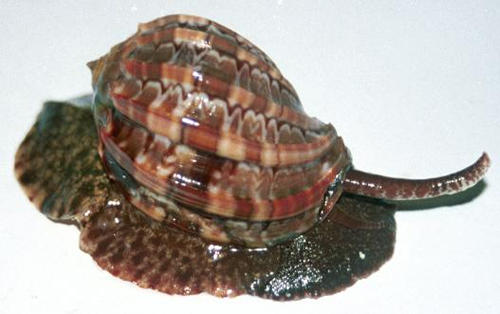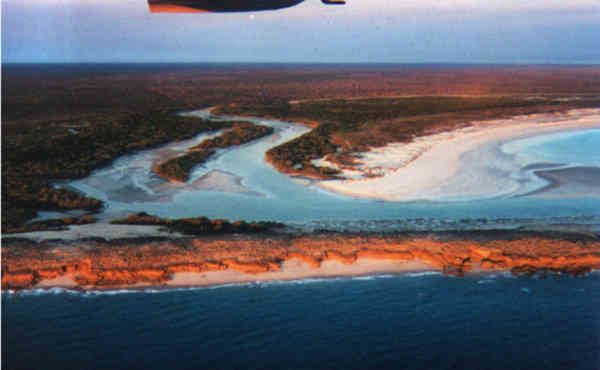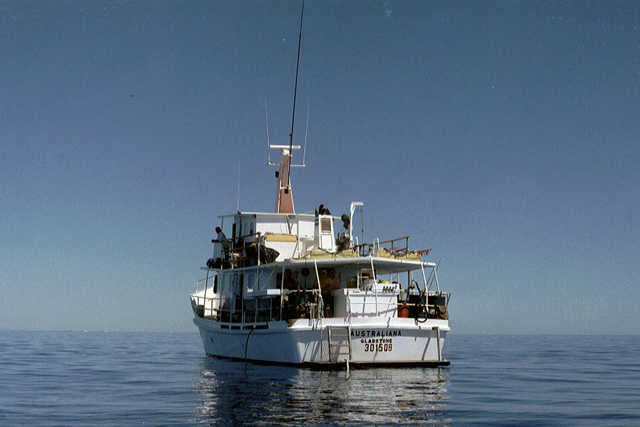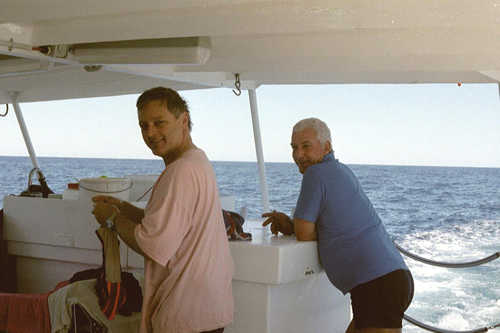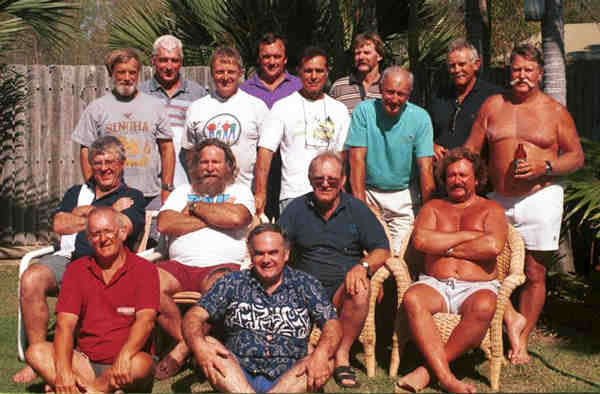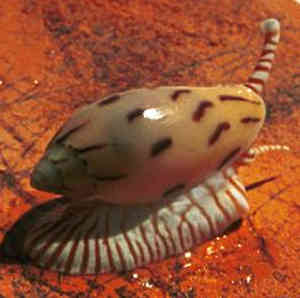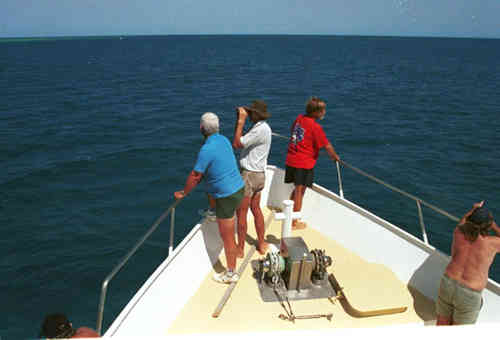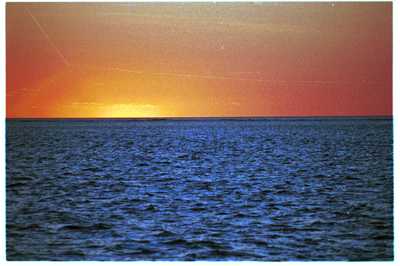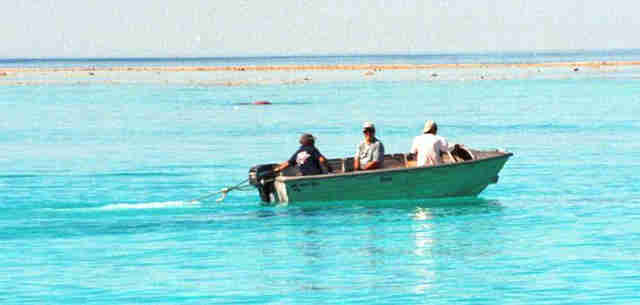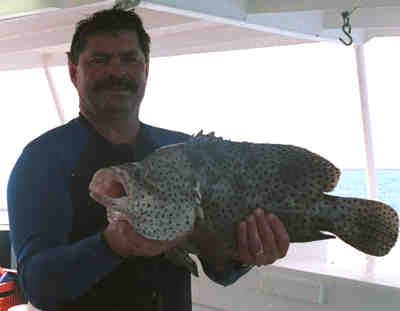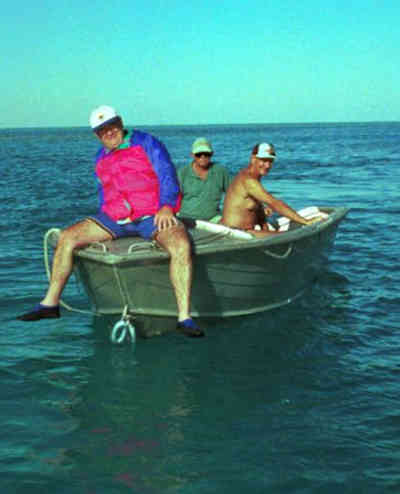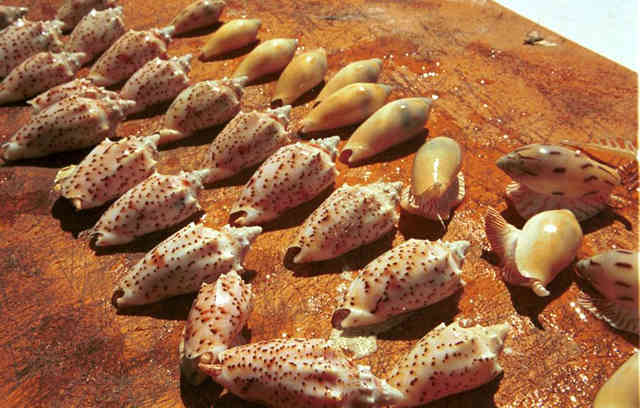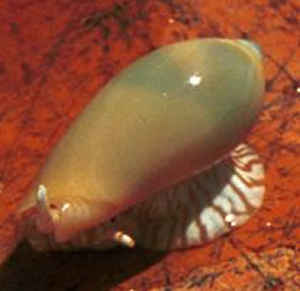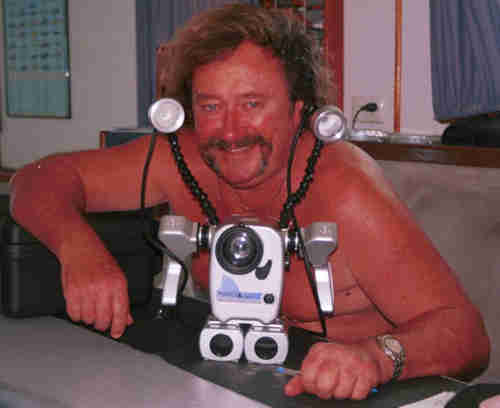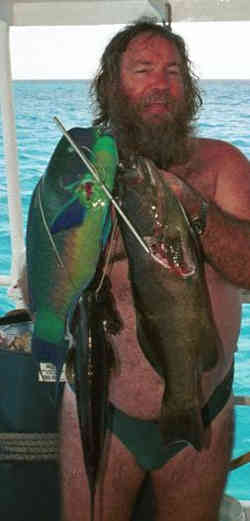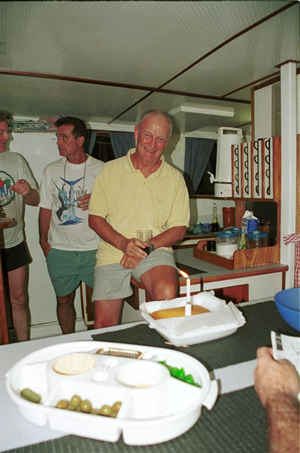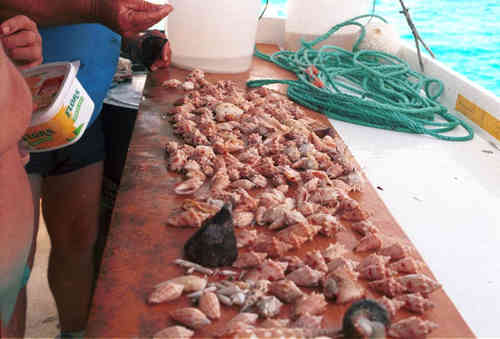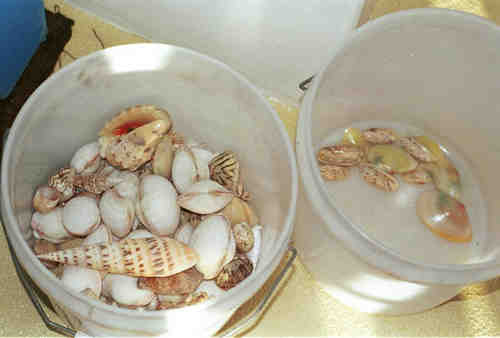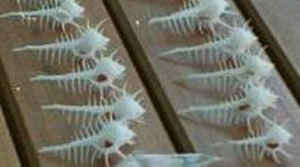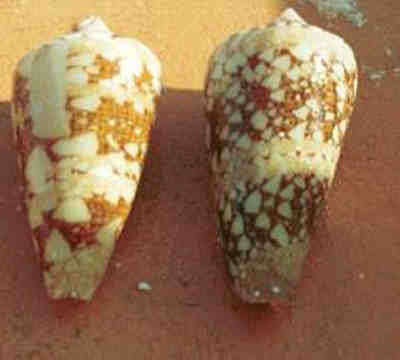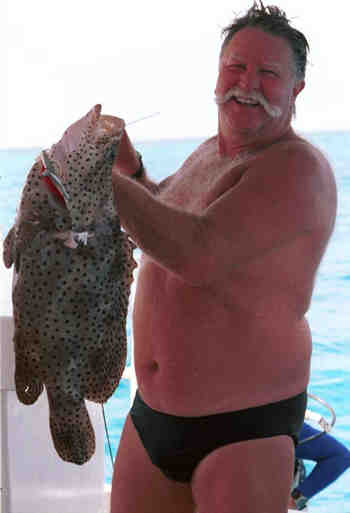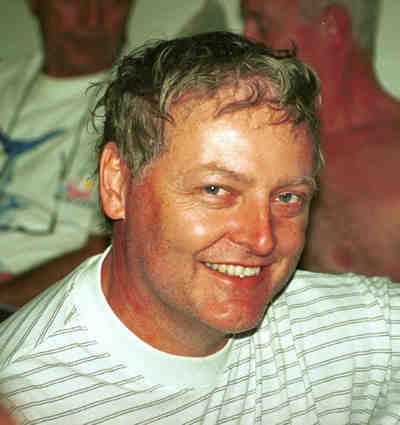|
|
August 2000 - September 2000 |
|
|
Some of the topics inside:
Shelling in Broome
'Old' Broome is on the Roebuck Bay (southern side) of the peninsula. Here is history and so much to see, to do and to experience. Cable Beach is on the northern side and faces squarely into the Indian Ocean. The spectacular cliffs of Gantheaume Point separate the two very different natural and cultural environments.
1999 - 2000 President's report In August Michael Keats gave a report on his continuing research of the molluscan fauna, dead or alive, of Shark Island. His recent surveys have become especially interesting since the oil spill in Sydney Harbour. In September Ashley Miskelly showed some of his new slides of finds in Sydney Harbour. Ashley and Ernie Uhle continue to find the most amazing shells at Bottle & Glass rocks. There were also some slides of his visit to the GBR. In October we held our annual shell show hosted by Ron and Marina Moylan. There were some really good entries. The November meeting was cancelled in favour of branch members attending the Christmas party of the Malacology Section of the Australian Museum at Winston Ponder's house. A great time was had by all, although it was a pity we did not get Winston to show us how he abseils down his back yard to get rid of the weeds. In December we held our own Christmas function at Kurnell Beach. A small but eager (and some very young) band of shellers attended on this beautiful day. In January Stephanie and Patty held another shell quiz with some very interesting questions. The February meeting was well attended when Chris Barnes spoke about the Cowries of Little Bay. Chris and Karen continue to find many unusual species, which shows that yes, the shells are still there, it just requires patience and time (and no children) to find them. The March meeting was cancelled because more than half of the members that usually attend branch meetings went to the National Shell Show in Adelaide. Members did quite well at the show. Chris and Karen won a second in the cowries - a hotly contested category, and whenever I looked at Ron Moylan's table, he was selling shells! We had a quiet April meeting, with members talking about their experiences in Adelaide and other field trips.
At the May meeting, we had Peter Middelfart from the Australian Museum give
a talk about egg capsules in Muricids. Peter showed up how you can tell the
difference between species and groups of species by their egg capsules.
Collecting in the Swains Reefs
I was lucky enough to go on 'Rat Pack 2000', this year's shell collecting trip organised by Doug Thorn. It was for 10 days in the Swains Reef part of the Great Barrier Reef, and was on a vessel Doug owns that is normally chartered for corporate fishing trips (The 'Australiana' shown above).
For this trip we had 15 shell collectors, plus one dive master (Chris) one deck hand (Danny) and one skipper (Malcolm Cox). From Sydney there was Adrian Browne, Ron Moylan and myself Steve Dean. From southern NSW there was Bob Kershaw specialising in Haliotis, along with his friend Barry Mead who had never been to the reef before and came along to see the reef and to snorkel. There was Mike Hart from NZ, Merv Cooper from WA, Rob Ekert and Charley Taylor from northern QLD, Doug Thorn and Malcolm Ford from Gladstone, Ray Oakey from Brisbane, Fred Schroeder from Guam, and Alain Robin and Pat Bail from France.
Pat, Doug and Malcolm are exclusively interested in Volutidae. Pat co-authored the recent book on the pulchra series. Fred's main interest is Mitridae and Murex. The rest of the collectors have an interest in a broader range of families. As a result there was a heavy emphasis on dredging and diving the sandy lagoons inside the reefs (10m to 20m depth). There were few reef walking and snorkelling excursions. This suited me fine, as all my previous collecting in the Swains had been all reef walking and snorkelling. It rounded out my collection primarily with Barrier Reef sublittoral sand shells.
We went to six different reefs in the Northern and North Eastern Swains. Three of these were chosen as new ground where few if any shell expeditions had been, and certainly no one on board had been to before. Each reef consisted of a fringing reef sheltering a lagoon area. Some reefs were half moon shaped and over 10km long, others completely encircled their lagoons with only a small entrance and others had many fingers of reef extending into the lagoon area. None had islands, and only for the first five days were there any exposed reefs at low tide.
The trip started from Gladstone Port on a Saturday late August. Everything was loaded onto the boat including the four dredges and a fourth run-about dinghy. As it was Doug's vessel, his normal shore staff cleaned the boat, and stocked it with all the food drinks and supplies. There was only a limited amount we could do to help. Doug was well organised, ably assisted by Malcolm Ford.
We left port late Saturday afternoon and travelled 19 hours to arrive at the first reef the middle of the next day. We had travelled in a straight line NE into a brisk NE wind, resulting in more than half of the collectors becoming sea-sick during the first evening. I had the honour of being first. (Seconds of dinner had not been a good idea, and so much for the seasickness tablets - next year I will bring stronger tablets). Other than for the first 24hrs the ocean was very calm. The "Australiana" picture was taken 180km off the Australian coast and is calm because it is inside one of the lagoons, but even in the open waters on the return trip to Gladstone the water was just as calm. Some days were windy creating a chop noticeable only in the dinghies.
Those of us with new items in our scuba gear dived the first afternoon to check them out before the night dives, while the others dredged. The first two reefs and the fifth reef did not yield a lot of uncommon material, so we stayed less than 24hrs at each. The third and fourth reefs warranted a day and a half each. The final reef was a good all round reef so we stayed three days, since quick looks in nearby reefs did not show anything promising.
Chris the dive master had four special skills, reciting poetry, telling jokes, ensuring all dives were safe and spearing fish. He was great at three of these - we had only one fish dinner during the trip. All meals were spectacularly large and very well cooked by the crew.
At the start of the trip eleven people on board were scuba divers by the end there
were thirteen. Each move to a new reef was only a few hours sailing, and the weather was good so both the skipper and the deck hand, took the opportunity to learn to dive and then get certified - our dive master was always available to help. Calm crystal clear waters in sandy lagoons is a perfect place to learn to dive, and there is the coral and fish to look at, but it will mean all other locations they dive will not be as good as their first dives.
The three main types of volute we were collecting were Amoria canaliculata, Cymbiola pulchra forma peristicta and Amoria maculata. Their colour and size varied dramatically from reef to reef.
There was a theory amongst the Volutidae fanatics that if Ethalia guamensis shells were coming up in the dredges we would find Volutidae. They postulated the guamensis were the food for the Volutidae. This seems unlikely as the guamensis seems to have the ability to hurl itself up from the sand about 75cm when threatened and then 'swim' away up to 1.4m by extending its body out from the shell and by twirling it thus moving itself in a rapid corkscrew motion. If this is the case the Volutida would be hard pressed to catch them. Ron and myself witnessed this rapid swimming as a dredge slowly passed while we were diving. At first it looked like they were being flung upward as they hit the dredge similar to a lawn mower throwing rocks. Then we noticed their body doing its swimming action, and then we realised the dredge was in soft sand with nothing hard to fire the guamensis against. We did not however do any serious investigation.
We reef walked at three reefs and snorkelled at others. There were not many rocks to be turned on the reef walks so we did not get many Cypraeidae
Ray brought hookah gear with him and Adrian became a hookah junkie, doing many dives in the lagoons from the main boat. Each hookah line was 100m long and the lagoons shallower than 20m, so a large area could be covered. Adrian even got to experience how to do an unplanned free assent when the hookah compressor stopped.
One evening, at the last reef, Chris was fishing off the side of the boat and hooked a shark. As it thrashed about on the surface, one of the two giant Groper that we had been swimming with and admiring for two days in the lagoon under our boat, surfaced and ate the shark with one bite, also biting off the line.
All shells collected by any means - dredge, walk, snorkel or dive were placed on the fish-cleaning table. The uncommon specimens including most of the Volutidae, some Conidae some Mitridae and most of the Murex were placed together for dividing up at the end of the trip. All other shells were available for any one who wanted them. Any that no one wanted, along with any shells that were immature, were thrown back before they died. We each had a large bucket with lid for storing our booty in diluted methylated spirits prior to cleaning.
I was the most general collector, showing interest in all species. Few others were interested in the less glamorous bivalves, no one else was interested in echinoderms, and there was little interest in small shells - Nassariinae and Columbellidae etc. As a result I probably ended up with the most shells in total, albeit common species. (Of course more specimens means more work cleaning. Nearly all my specimens have now been cleaned and bagged). There were enough shells found that anyone interested in a species or family could get an adequate number of specimens for themselves. As the days progressed the list of shells that everyone had more than enough of kept increasing and they were banned from being brought back to the boat so they did not have to be thrown back.
Last year a percentage of the uncommon shells was not divided amongst the collectors, but was retained by Doug and sold to cover the incidental additional boat related costs, dive masters fee etc. For shell dealers who relate shells to a dollar value this is not a problem, but to shell collectors it presents as a loss of collected booty. As a result this year it was decided we would put in an additional $50 each to cover the extra boat costs. That way there was no need for a boat share and all uncommon shells were divided equally.
Everybody including Doug got exactly the same quantity and value of shells. Fortunately there was adequate numbers of specimens such that nobody had to miss out on varieties they wanted, and very little swapping needed to be done at the end.
I have three brothers, and as a youngster at meal time all food was divided into exactly equal portions, or there was big trouble. I have never seen a divide up of anything done more fairly or more equally than the divide up of the uncommon shells from this trip.
Doug put in a mammoth effort before, during and after the trip to ensure it went smoothly, and to keep us focussed on successful collecting. We are all very appreciative and are looking forward to next year's trip. In the next Sheller I hope to provide some idea of the variety of species found by listing many of them.
|
||

